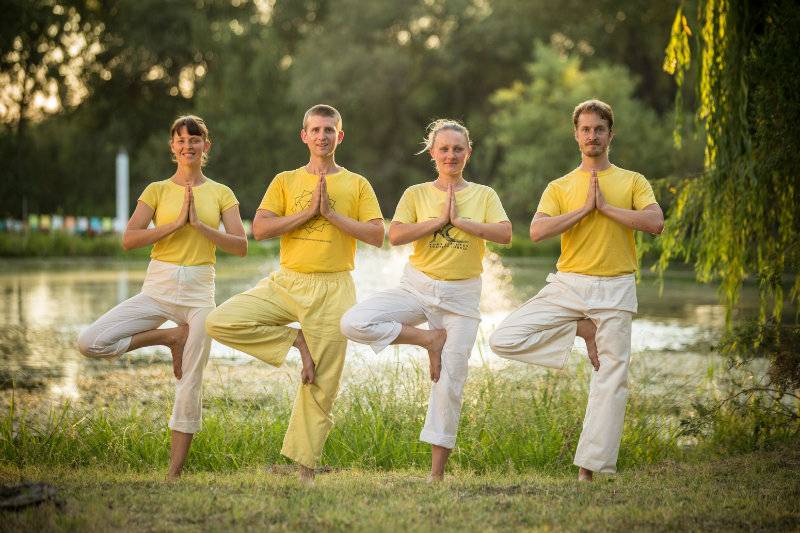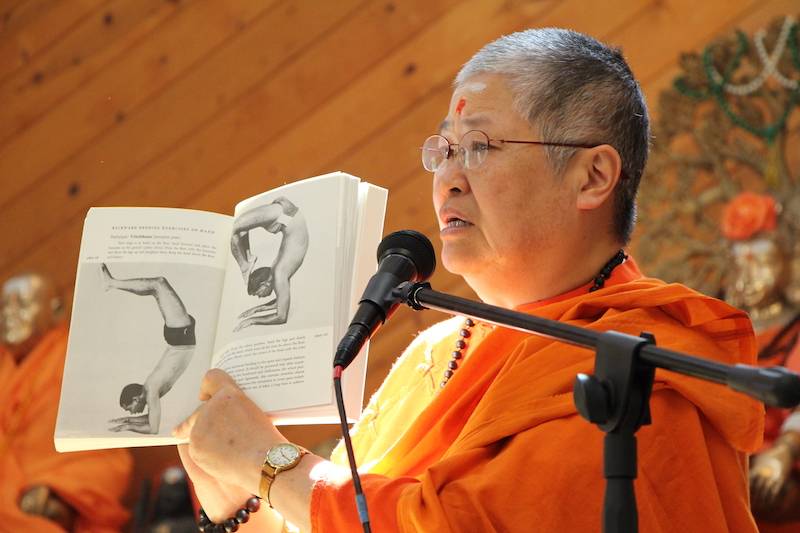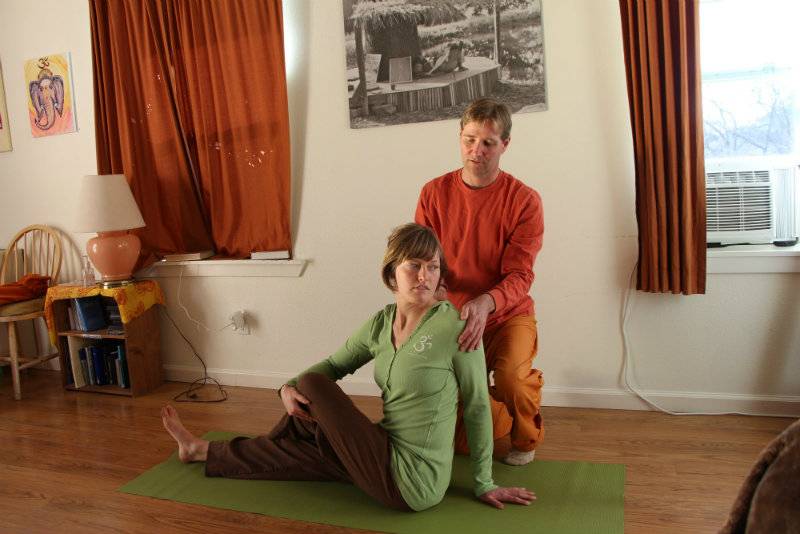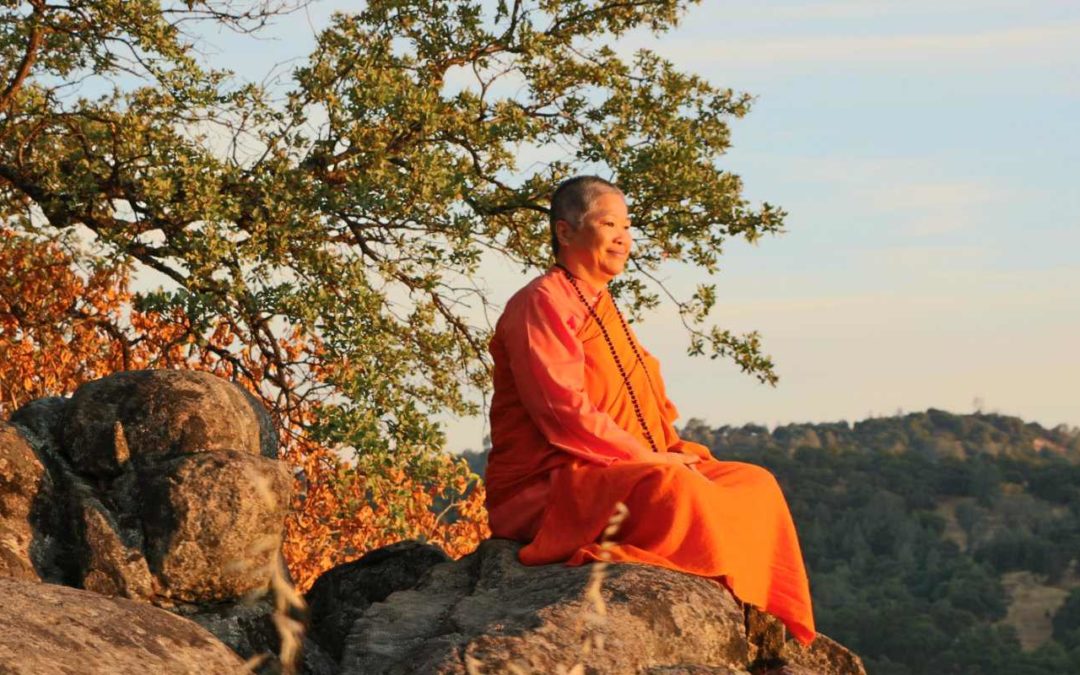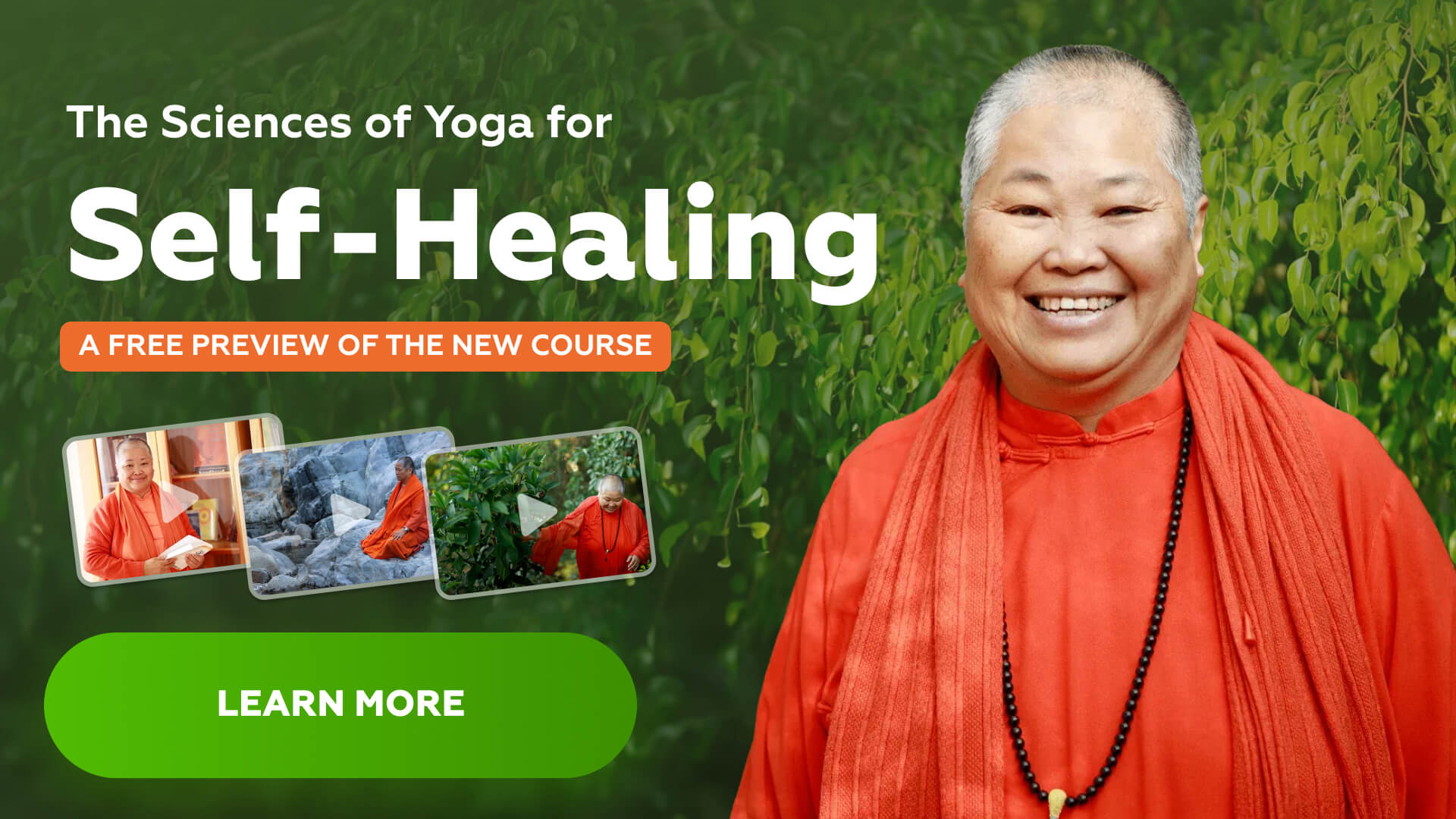
Why We Chant
Why we Chant
by Swami Sitaramananda
There is another way to connect to the inner truth within you. That is through chanting. If I go to a restaurant in China, I want to order food and communicate with people, then I have to speak Chinese. If I go to Spain, then I have to speak Spanish. If I go to Vietnam, I have to speak in Vietnamese. If I go to heaven, I have to speak the divine language. So Sanskrit is considered to be the divine language. It is universal. It’s not Indian. It doesn’t belong to any culture. It belongs to you.
Kirtan Chanting is a Divine language that talks to your soul
The Sanskrit language has the vibration in your chakras; that means in your energy body.
When I went to a Yoga retreat for the first time, I heard the chanting for two days and the chants followed me home. It is not a normal language. People can talk to you, and then you forget. But the divine language talks to your energy directly, and it says things to you that you cannot even understand.
It is said that it will remove all impunities in your astral body, or remove all the impurities in your heart and in your mind, and communicate with you about the divine truth that is within your heart and is universal. That is why mantras are made of the Sanskrit alphabet.
Power of Music
Now with mantra, you have the music. Kirtan is made of mantra with music and melody. Music is very powerful. It can bring joy and calm the mind down. If somebody is angry at you, you sing a song, and then they will be ok.
Because kirtan is the language of the emotions. Now, you have Sanskrit/Mantra, and you have music/melody.
Now, the third thing you have is your love. Because when you love somebody, you like to repeat their name. You like to talk to them all the time.
Story of attachment
I know a lady and she loves her son. When she meets with us, she talks about her son all the time, “My son did this, my son wears this kind of clothing, my son plays this sport, my son is good in school…” All the time, she finds stories to talk about her son.
So we were traveling in India, and on the bus she talked to everybody about her son. So one day, we went to many temples, and in the temple, you have to bow, you have to get the three powders and you have to drink some water, which are symbolic actions. She is tired. She is from America. And she said, “I don’t want this temple business. I don’t like it anymore.” To say that one time is okay, but when you say it many times it is more than just curiosity, it becomes a practice.
Understand Symbols
She said, “I don’t want it anymore, all this temple business.” And then on the bus, she took a photo of her son and passed it along to everybody. When the photo came to the swami there at that time, he was about to tear the photo. She said, “What are you doing? It’s my son.” So the swami said, “It’s not your son. It is just a piece of paper.” “It is my son’s picture. It’s a picture of my son!”
So the swami explained, “The same thing in the temple, you have the picture or statue, they are made of clay, they’re made of paper, or they made of metal. It’s just the symbol.” It’s like the flag of a country. If you are going to take the flag of a country and wipe your feet, you will be put in jail. It just a piece of cloth. So it’s not just a piece of cloth, instead it’s the idea behind it that you respect.
Any symbol, like the picture or statue or image of God, just represents the divine reality that is universal and that is within you, but you forgot. So you have a symbol, so that you can remember. That’s all. The way our mind works is with sound or image.
To think about something you cannot think about something abstract, you have to have words so that you can describe it. And you have to have an image.
Let’s say I say the word apple. I say apple, then I see a round shape. Let’s say I say a house. I have the word, then I have the image. But each person will have a different image, you might have the image of your house, another person may have the image of a big company, another person has a small house image… It doesn’t really matter what kind of image you have.
But the image comes from your mind, and the image comes from something you already know. Just the same, if you want to communicate with the divine, you have to communicate through the language and through image.
Connect to the Truth
That’s how you connect to the universal truth that is within you. The truth is not outside. It is not on the altar. It is not in the temple. The guru is not in the guru either. It’s not in the body of a person. It’s a universal truth that the guru has realized, and he shows you the way how to realize this truth yourself. It’s not something external. It’s something inside you.
When we chant, remember again mantra, which are pure sounds in Sanskrit that resonate with your chakras, purify your mind and bring pure energy to your mind. The next thing is the music, the melody that makes your emotions feel good. What’s the next?
It is the love that is within you, that you express through the love of the name and form that represents the divine. It doesn’t really matter, what name or what form. Everyone has love inside. But you’re not just loving your husband, your wife and your children. There is an essential love within you.
Divine Love
That’s the love of the divine, or love of the truth within you, or love of the Creator, or love of something that is connecting everyone together. We say love of the sun. It’s like the sun. The sun is shining on everything, and giving life to everything. The sun gives light and life. That inner sun, everyone has it. We say that’s the inner truth or inner light that gives light to yourself or your soul, makes you and me one, and connects everything together and makes everyone have light and happiness. Sometimes there is darkness inside, which comes from our own mind.
So the mind is busy thinking, “I don’t have enough money, I don’t like my job, I don’t like my relationship.” So this kind of mind and thinking creates the blockage to the light. That’s why we need to chant, loud! We express our love and devotion. We express our connection to that inner sun. So we bring the best thing within us outside.
We use Kirtan music and Mantra to be happy. So it cleanses the body and mind, especially, uplifts your emotions, and it opens your heart. Kirtan is about clearing away all the negative emotions, so you can connect to the divine within you. That’s very simple.
Mantra sacred sound
I can talk more about Mantra. Mantra is a sacred sound formula that resonates and that lifts your consciousness from a low level to a high level. It is a sacred formula given by teachers that have realized these mantras. They realize the power of the sound and the formula of the sound.
As I said, if you speak a language, you have to speak correctly so that the other person understands you. If you just say words without being correct, nobody will understand you. So the Mantra is a way of connection that is given to us by these Yoga masters, and we’re receiving it. (You chanted very nicely. I’m sure for many of you it’s the first time.)
The idea is not that you are chanting good or bad. The main thing is that you just have to feel the love and devotion, and then you have to be willing to open your mouth and follow the chant. It’s very natural within you, and your whole body and your whole mind will go with it, and you feel good and you don’t know why. You feel happy and you don’t know why.
I can explain the meaning of these words. These are the Daily Chants being given by Swami Sivananda from the Himalayas; that Swami Vishnudevananda-ji adopted in his Ashrams called the Sivananda Yoga Vedanta Centers. Of course, we learned it. We have been chanting it for years every day, morning and evening. These are Mantras. The more you chant, the more beautiful they are. These are not just some songs to entertain the emotions. These are the names and sounds of the Divine. You want to wake up the Divine within you, so you chant the mantra and you feel good.
Ganesha
So in the beginning, we always worship Ganesha, which you see on the altar, the elephant-headed one. The elephant is a very big animal, they are very wise, they live long, and they are vegetarian. They have big trunks. Wherever they go, they remove the obstacles. It says that when we live in life, there are obstacles that come from our mind, such as our own beliefs about ourselves and everything else. We need to remove these thoughts out of our way.
Then we can connect to the Divine, to our own inner light and our inner intelligence. Ganesha has the body of a human and the head of an elephant, which means when you change your head to become the head of wisdom, then you are a different person, and everything you do and everything you think would be okay. It will not create obstacles for you, and everything will be good in your life.
Do you want everything to be good in your life? So every day, pray to Ganesha. If you think about it a lot, all the time you pray, May all the obstacles be removed from my life, my life be successful, my health be good and my family be good and my relationship also good. So symbolically, you keep a picture of Ganesha, because the subconscious mind works with image. Inside of us, there is a kind of mind that works with image and symbols.
Like for children, you cannot reason with them too much, but if you draw a picture and tell a story, then children understand. So the same thing with us, there is a kind of mind inside of us that understands stories, understands pictures, but doesn’t reason very well. This is the way the sages communicate, by image and Mantra, so we can understand something that our reasoning cannot understand. This is Ganesha.
Lakshmi
Now you see here, Lakshmi. Lakshmi is like Kuan Yin, the female form, very beautiful, sitting in lotus, holding a lotus in her hand. Lotus represents purity, so she’s the one that makes you understand that you need to be purified, then you will be able to bring the good energy to you.
That good energy will give you health, give you money and success, and also remove negativities out of your mind. She will give you everything good: good food, good friends, good company, everything good, so that is Lakshmi.
Krishna
Now here in the middle, you have Krishna. Also it’s a symbolic representation of Divine Love. He is standing with a flute in hand. So the teaching is to empty yourself like the flute and remove your ego, and I will play beautiful music through you. He’s very nice.
He is standing in the moonlight. See the moon? It is more for those who like the moon. Some people like the moon, and some people like the sun. It’s just different characters. It doesn’t matter. The teaching gives you many images. So you can choose what you want, depending on your mind. Just like some people like green apple, some people like yellow apple, and some people like red apple.
It doesn’t matter. So you have the image of Lakshmi. You have the image of Krishna. It is very beautiful, very romantic, in the moonlight chanting music. Maybe for you, this is very important.
Saraswati
Then you have Saraswati. She is a beautiful female, and she plays music. She has a book in her hand and she has mala beads in another hand. And she has the swan. She sits on the white lotus. It’s a different energy. You see she is very calm and very pure. She represents the purity within you. You have that purity, then the knowledge will come.
Durga
Then you have Durga. You see she is very different. She sits on a tiger or a lion. She has many arms, and in every hand, she has a weapon. She has a sword to cut. She has the bow and arrow to shoot. She represents the power of action of the divine, and that is stronger than your own mind, which can remove all the negativities in your mind. And she becomes victorious.
Sometimes, we fight against our own negative emotions, our fear, our anger, and our desires, and we cannot make it. Our desires and negativities are stronger, so at that time you call Durga. You place a picture of her, and you say, “Mother Durga protect me”. And she will come and she will fight and you will feel good.
Conclusion
So whatever you want, you can place a picture. And you can connect by devotion and by prayers, then it will happen. So what will happen? You will feel good, because inside of you, the peace is there, happiness is there, everything you want is there, but there are many obstacles that come from your own mind.
So chanting Kirtan can remove the obstacles, and practicing love and devotion will lift you up, make you more able to love, and then after that, you can love everybody in your life, and when you love, you become happy.
Yoga Teacher Training Course
Check out our 200-hour Yoga Alliance certified Yoga Teacher Training Courses offered twice a year in California, 3x in Vietnam, once in China and once in Japan.
Foundational Courses
Choose from upcoming courses for beginners and intermediate level students.
Yoga Vacation
Rejuvinate your body and mind. Experience and progress with daily Yoga classes. Learn the 12 basic asanas and pranayama. Enjoy daily meditation, chanting, and organic vegetarian meals.
Rejuvenate Your Being
Follow us
[et_social_follow icon_style=”slide” icon_shape=”rounded” icons_location=”top” col_number=”2″ counts=”true” counts_num=”0″ outer_color=”dark”]
